The .450 Marlin is the most powerful lever-actioned caliber created and the third, by far, amongst those operationally usable in wild boar battue hunting. For some time now, I have wanted do an in-depth testing both at the range and hunting wild boars with this caliber but it was difficult to fetch all three the battue weapons available on the market that are chambered for the powerful Marlin/Hornady creation. In fact, the three lever-actioned weapons available in .450 Marlin are the Browning BLR Light, the Marlin 1895M, both still in production, and the Winchester 94AE Timber, which recently has been discontinued (however, there is talk of a possible reintroduction). It took me almost two years to find all three weapons, but eventually I succeeded, and I was able to prepare a series of tests with both of the selected Hornady ammo loads.

There is also a fourth weapon chambered in the .450 Marlin: The Steyr Mannlicher Big Bore, a bolt-action rifle designed almost exclusively for recuperators. Although, given its features, it would have been quite unsuitable for the purpose of this test, based on boar battue. As mentioned above, in reality the .450 Marlin caliber is a created by two hands, or rather, the product of a synergy between Marlin and Hornady. The aim was to create a caliber that was more powerful than the .444 Marlin and the old .45/70 Gvt, both limited because of the poor range of the commercial cartridges, which forced users to use ammo reloading, a practice not possible for most people. This powerful caliber was officially presented at the 2000 Shot Show together with the Hornady 350 grain ammunition from the Custom Interlock line, followed by, after only five seasons, the revolutionary LeverEvolution 325 grain with FTX bullet. This round had a lot of success in the United States, especially on the guide gun market, weapons used by guides for dangerous game and big game hunting.
In fact, this powerful caliber, in combination with light and short guns, featuring easy and fast handling and follow up shots, allows not only to hunt well at short and medium distances, but, above all, to be able to double hit large and dangerous animals in the woods. Its heavy bullet with a medium to fast thrust is an absolute guarantee even in the most difficult situations. Letʼs see some numbers by comparing them with other top of the category calibers, obviously equal to the maximum conditions offered by commercial ammunition (maximum bullet weight for the caliber).
Caliber Bullet weight and type V° Energy° Recoil Factor
.338 Win. Mag. 250 g N. P. 2660 ft./sec 3925 ft./lbs 2.93
9.3x62mm 293 g S. P. 2430 ft./sec 3842 ft./lbs 3.55
.450 Marlin 325 g FTX 2225 ft./sec 3572 ft./lbs 3.27
.450 Marlin 350 g FP 2100 ft./sec 3427 ft./lbs 3.27
.300 Win. Mag. 200 g N. P. 2825 ft./sec 3544 ft./lbs 2.39
9.3x74R 285 g P. P. 2362 ft./sec 3532 ft./lbs 3.45
.35 Whelen 225 g TBBC 2600 ft./sec 3375 ft./lbs 2.64
.338 Marlin Express 200 g FTX 2565 ft./sec 2921 ft-/sec 2.28
.444 Marlin 265 g FTX 2325 ft./sec 3180 ft./lbs 2.54
.45/70 Gvn’t 325 g FTX 2050 ft./sec 3032 ft./lbs 2.43
.30-06 Springfield 220 g SP 2410 ft./sec 2837 ft./lbs 2.19
.356 Winchester 200 g PP 2460 ft./sec 2688 ft./lbs 2.22
As can be seen from this table, currently, the .450 Marlin, in terms of pure energy developed, is the third most powerful caliber among those operationally used for hunting boar. However, if we consider the energy offered in relation to the weight of the bullets of the first three calibers at the top of the category, the .450 Marlin offers an extremely balanced and useable whole, as for the relationship between energy transfer and penetration, compared to the .338 Winchester Magnum and the 9.3 x62, given its 325 grains against the 250 of the first, and the 286 of the second. The end effects of this caliber, even compared to the competition, are something that can only happen in the field of hunting: in fact, the numbers say something, but not everything. Moreover, the importance of the recoil factor must be taken into account. This factor relegates the .450 Marlin, in third place after the 9.3x62 Mauser and the other German 9.3x74R, which are really “heavy” on the shoulders of the hunter.
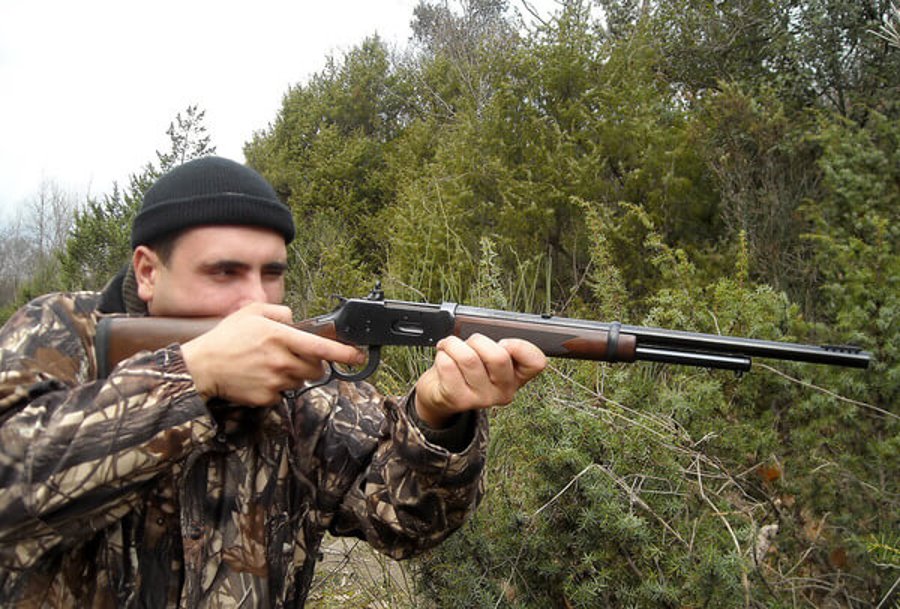
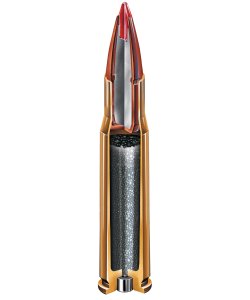
The .450 Marlin
We can now talk about the weapon models we selected in the .450 Marlin caliber. Marlin, currently, offers two versions of the 1895 model in the .450 Marlin, the guide gun or 1895M with a 18 ½” barrel, and the 1895MXLR mechanics and 24" barrel made entirely of stainless steel. It is unfortunate that the version with 22” barrel was produced for one year only since it had an exceptional ratio between ammunition performance and flexibility of the weapon. Browning offers the BLR Light Weight model in two different configurations, the Affut and the Take-Down, both with a 51 cm barrel. On the other hand, Winchester offered the Timber with a 46 cm barrel and muzzle brake. The advantage of the Browning BLR lever-action weapons, compared to the classical Marlin and Winchester, is that the Browning, which has a detachable magazine loader, can chamber spitzer or semi-spitzer cartridges. This is absolutely excluded from the two American models with tubular magazine. In fact, spitzer cartridge points in the tubular magazine could spark ignition with all the relative consequences for the shooter and the weapon. However, a minor disadvantage of the BLR compared to the Marlin and Winchester is the lower availability of shots: The BLR has only four shots - three in the magazine and one in the chamber - compared to the five shots of the Marlin and Winchester.
Ammunition
We tested two products both by Hornady: the Custom Interlock 350 grain with Flat Point bullet and the LeverEvolution with 325 grain FTX bullet with an anti-ignition apical made of special rubber. These two bullets cover the needs of the two types of typical .450 Marlin user, or rather, the guide/recuperator/hunting dog breeder, whose mission involves the use of very heavy bullets for short and very short distance shots, especially in the woods, and for spot and stalk hunters who may need to make longer shots. In any case, this caliber uses 458” bullets such as the .45/70 Government and the .458 Winchester Magnum. In this context, the recharging may offer additional solutions, both soft point and solid type products.
Below are the basic characteristics of the two Hornady ammunition.
LeverEvolution with 325 grain FTX bullet (code No. 82750)
Muzzle speed: 2225 ft./sec (678 m/sec)
Muzzle energy: 3572 ft./lbs (494 Kgm)
Energy at 90m: 2569 ft./lbs (355 Kgm)
Energy at 180 m: 1813 ft./lbs (251 Kgm)
Energy at 270 m: 1278 ft./lbs (177 Kgm)
Custom with 350 grain FP bullet (code No. 8250)
Muzzle speed: 2100 ft./sec (640 m/sec)
Muzzle energy: 3427 ft./lbs (474 Kgm)
Energy at 90 m: 2298 ft./lbs (318 Kgm)
Energy at 180 m: 1516 ft./lbs (210 Kgm)
Energy at 270 m: 1039 ft./lbs (144 Kgm)
As can be seen from these two tables, the differences in performance of the two ammunition are quite considerable, at least in the medium and long distances (basically beyond 90 m) both in terms of speed and energy, which affects the bullet drop levels. In any case, the long-distance shooting and the bullet drops are not matters that concern the user of the “battue” version of the .450 Marlin since the standard range of use of the caliber remains confined within the 100 m of distance, at most.
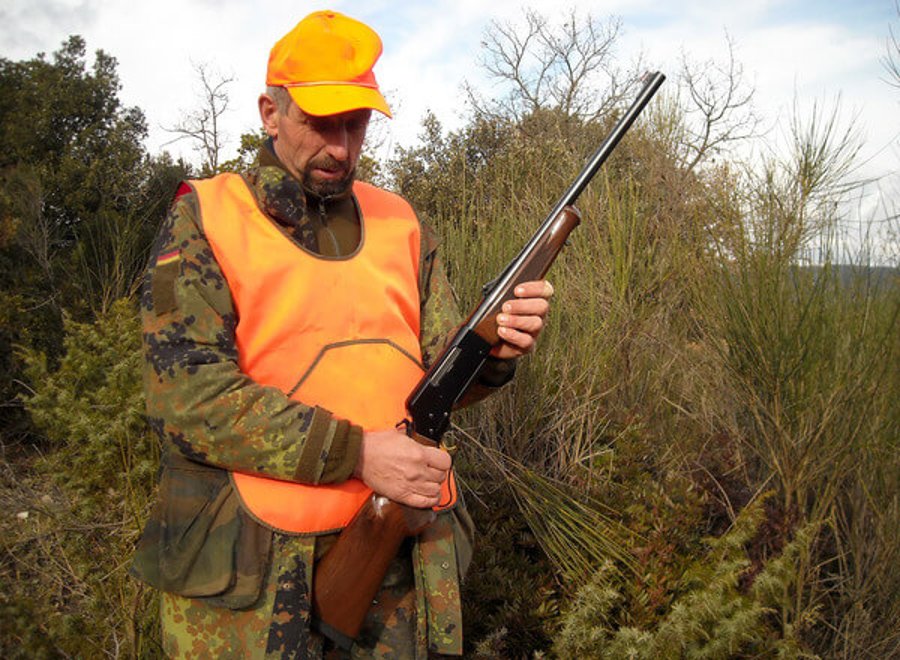
The three guns
Technical and practical notes. Although they are all lever-action guns, the three guns differ greatly in mechanical design, style, ergonomics, overall dimensions, and distribution of weight and total weight. The difference is so great that it is not easy to switch between them without being familiar with them. In particular, as per sight, the user needs some time in getting used to target acquisition. So, it was not an easy task.
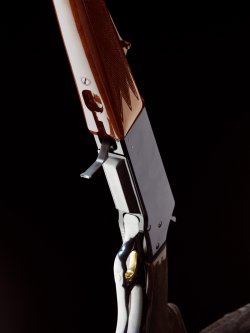
I must say that among the three, the Marlin is the quickest to aim, followed, on an equal footing, by the other two. The sights of the W94, however, the Ghost Sight type, must be used with both eyes open, which means that some training is required for optimal use. I replaced the original BLR and Marlin sights with a red fiber optic since it is barely visible. Regarding the shouldering, I would say that all three are very fast with a slight margin of more speed for the Marlin. Given the greater length of the barrel, the BLR is slightly imbalanced in the front, but this is only noticeable when holding the gun in the standby position and not during shooting. A quite important note on the safety catch. The Marlin and the W94 have a double safety latch, the hammer in the half-cocked position and the push button safety (Marlin) or the slider safety (W94), which are particularly silent in operation during the stalking and extremely safe and easy during action. On the other hand, the BLR has two safety catches, the half-mount and a reverse trigger that, although easy to engage, are quite noisy.

Letʼs now see the impressions on the speed of the lever action, recoil and muzzle climb of the three rifles. The W94 was the worse in terms of recoiling, especially because of its lightness that, despite the presence of the muzzle brake, makes the shot of the .450 Marlin uncontrollable. The BLR is good; the Marlin is very good, since it is well balanced, and sports a solid barrel and receiver. The muzzle climb is quite tame in all three rifles.
In the speed lever action arming race, the W94 and the Marlin (the best) almost tied, while the BLR is a little slow, both because of the action length and because of the (remarkable) force to be exerted on all of that steel: also some uncertainty in the magazine, if the three cartridges are not perfectly aligned within the magazine.
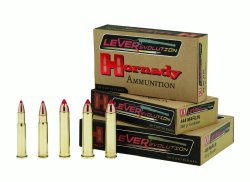
Shooting range results
First of all, since I considered it appropriate to test both types of Hornady commercial ammunition and in order to verify the differences in terms of ballistic performance both externally and terminal, I had to make a choice regarding the zeroing of the three guns, which was set for all rifles at the distance of 40 meters. So, I decided to zero the marlin 1895M with the Hornady LeverEvolution, and the BLR and the Winchester 94 with the Hornady Custom. However, once the three rifles were zeroed with the respective ammunition, I carried out two group of three shots each with the other ammunition to check the possible deviation in terms of rise, drifting and amplitude of group pattern. Here are the results.
At the DNA precision level, with both ammunition, the more accurate rifle (but by less than 10 mm) is the Marlin, despite the shorter barrel of than the other two and the lack of muzzle brake. I think that this is due to the higher weight and the better trigger of the Marlin compared to the two competitors. Under identical conditions, I am sure that the three rifles shoot almost equally, which is a bit typical of weapons chambered in slow and heavy calibers.
Here are the groups yielded by the three rifles: BLR 39x37mm; W94 38x34mm; 1895M 29x28mm. With the LeverEvo (1895M) weapon reset, the Custom impact a couple of centiliters lower, while the other two rifles reset with the Custom, the shots with the LeverEvo impact 5-6 cm higher: regarding derivation, the two munitions did not show any appreciable divergence. This fact tells us that, when resetting the rifles at 40-50 meters for battue hunting, one can safely use both the ammunitions without having to return to the shooting range for the reset. This is a bit typical of slow and heavy calibers although, in all fairness, the .450 Marlin is not so slow.
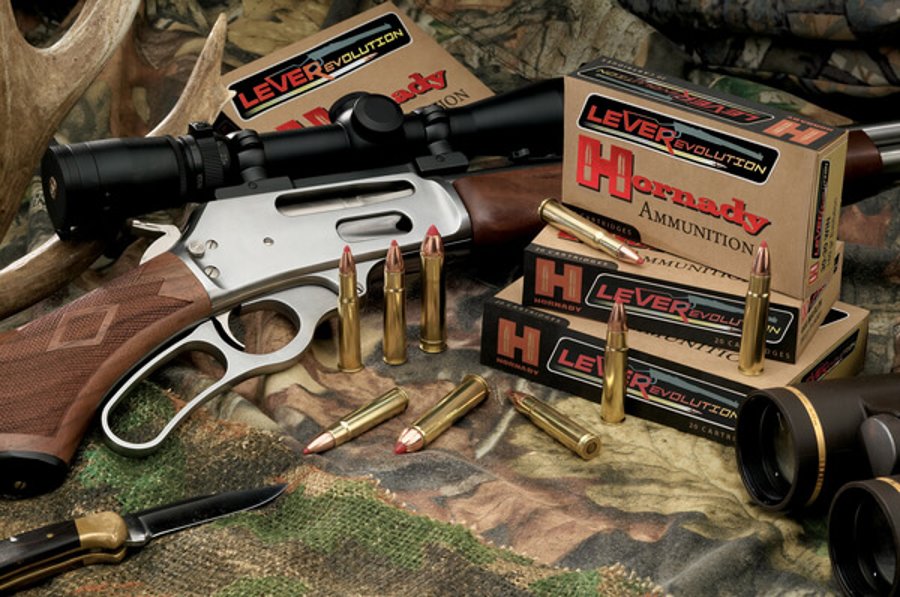
Hunting with the .450 Marlin
The first wild boar shot down with this caliber was a 60 kg male, caught with the Marlin and the LeverEvolution. The game was shot at a distance of 20 meters and collapsed on the spot, with one shot. But, this shooting down gives us a lot of information since the animal, shot in the kidney area, results to be struck dead at the rifle shot despite the complete escape of the bullet. First of all, this tells us that when attaining an average weight animal at a short distance, and in a point that is not extremely vital, the LeverEvo bullet in the .450 Marlin is able to fire off the right energy to strike the game dead on the spot. Moreover, the loss of meat was minimum (approximately 1 kg): the entry hole was equal to the original diameter of the bullet, while the output hole was slightly wider.

The second boar was shot down with the BLR and the Hornady Custom FP munitions in a shooting during which three boars were shot. The first, 30 Kg game, shot at a distance of approximately 60 meters in the middle of the shoulder, travelled 7-8 meters before collapsing to the ground. The bullet went through both shoulders keeping the same diameter both inbound and outbound. The remains were perfect. Unfortunately, the other two boars, one was 60 kg and the other approximately 90 kg, shot at a standstill at a distance of approximately 35 meters, vanished. There were few findings on the ground: unfortunately it grew dark and there was a strong storm brewing so it was not possible to organize a recovery. For the sake of doubt, the rifle was verified at the range the next day: 2 shots at 50 meters, one in 10, the other in the mouche.
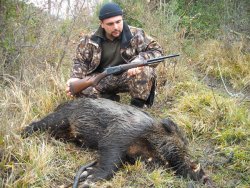
The initial impression had been that the 350-gr FP ammunition is too hard for the wild boar and thus acts as a full metal jacket. This is a wrong impression: rather, the next two boars shot down, respectively 20 kg and 50 kg, made me believe that it is a fairly soft bullet that makes expansion its main justification for existence so, with a frightening stopping power but at the expense of a noteworthy loss of meat. This leads us to believe that this ammunition is suitable for shooting very big animals at a distance between 0 and 60-70 meters, which is its leitmotiv because it is used for rifles called guide guns. This means that these boars were shot badly.
Conclusions
I can understand that the caliber could discourage some hunters (certainly not the most courageous and robust boar hunters) even though it is more bothersome to shot with a light or poorly balanced rifle in a .300 Winchester Magnum or in a 9.3x62mm. I can also understand how many people turn their nose up to lever action rifles because it does not allow for quick repetition of shots if the user is not used to it. However, I need to specify that it is possible to train properly without firing, or in “wet fire conditions” as the Americans call it by chambering a snap cap.
However, this caliber, combined with ad hoc ammunition, such as the Lever Evolution, gives the user everything thatʼs lacking in standard calibers in terms of stopping and killing power, plus an unsuspected respect of meat, which has great influence among wild boar hunters. Which makes it all very enticing, not only for those who are at the post, but also for those who go with the dogs and all those who wander.


